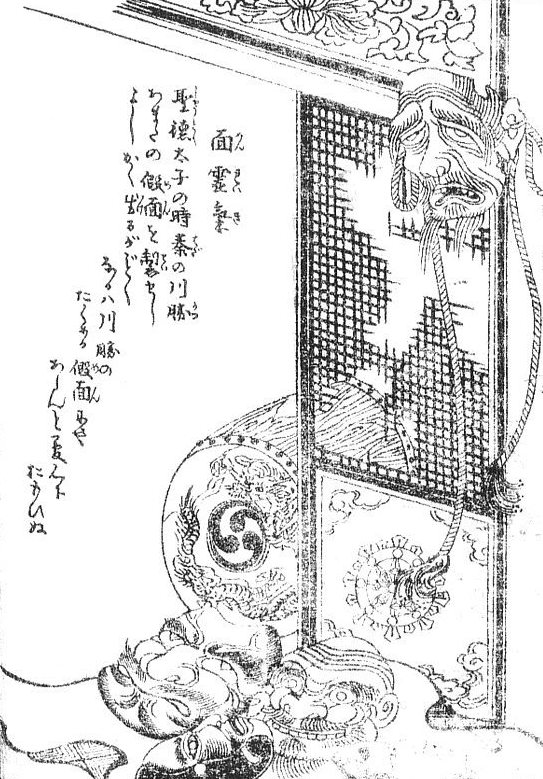|
Menreiki
is a type of yōkai in Japanese folklore, composed of Gigaku masks. It is listed within the 1781 compendium of Japanese supernatural entities, entitled ''Gazu Hyakki Tsurezure Bukuro''. It is mentioned in folklore that during the time of Prince Shotoku, the prince created various Gigaku masks which were used by Hata no Kawakatsu , sometimes called Hada no Kōkatsu, was a legendary figure in Japanese folklore, who is believed to have introduced ritual Shinto dances to Japan in the sixth century. He is also considered the progenitor of a hereditary line which includes many ..., and that the Menreiki is based on those masks.多田克己 『幻想世界の住人たち IV 日本編』 新紀元社〈Truth in fantasy〉、1990年、303頁。。 References Japanese folklore Tsukumogami {{Japan-culture-stub ... [...More Info...] [...Related Items...] OR: [Wikipedia] [Google] [Baidu] |
Gazu Hyakki Tsurezure Bukuro
is the fourth book in Japanese artist Toriyama Sekien's famous ''Gazu Hyakki Yagyō'' tetralogy. A version of the tetralogy translated and annotated in English was published in 2016. The title is a pun; "hyakki", normally written with the characters "hundred" and "''oni''", is instead written with "hundred" and "vessels". This hints that the majority of the ''yōkai'' portrayed in its pages are of the variety known as ''tsukumogami'', man-made objects taken sentient form. ''Hyakki Tsurezure Bukuro'' is preceded in the series by ''Gazu Hyakki Yagyō'', ''Konjaku Gazu Zoku Hyakki'', and ''Konjaku Hyakki Shūi''. Published in 1781, it was inspired in part by ''Tsurezuregusa'' (''Tales in Idleness''), a 14th-century essay collection by the monk Yoshida Kenkō. The book takes the form of a supernatural bestiary of yōkai. Unlike previous books in the series, the majority of ''Hyakki Tsurezure Bukuro''s yōkai appear to be of Sekien's own creation, based on turns of phrase or stories fro ... [...More Info...] [...Related Items...] OR: [Wikipedia] [Google] [Baidu] |
Gigaku
, also known as , p.357-8, on ''gigaku men" (mask) refers to an extinct genre of masked drama-dance performance, imported into Japan during the Asuka period. History Records state that was introduced during the 20th year of reign of Empress Suiko (612 AD) by a certain volume=5, page=483-4, article on gigaku by :ja:吉川英史 (Kikkawa, Eishi, 1909~2006, traditional music related art historian) from Kudara kingdom (Baekje), one of the Three Kingdoms of Korea. According to accounts, Mimaji arrived in Sakurai and taught to the Japanese youth. It is said that he had studied in Wu (China), showing that the origins of can be traced back to China, as during the Suiko period (593/604–658 AD), the Japanese court took heavy influence from Chinese and Korean culture. The regent at the time, Shotoku, played a decisive role in allowing and diffusing Buddhist culture within Japan; this spread of culture allowed to be performed and viewed by many Japanese individuals, as it promoted t ... [...More Info...] [...Related Items...] OR: [Wikipedia] [Google] [Baidu] |
Yōkai
are a class of supernatural entities and spirits in Japanese folklore. The word is composed of the kanji for "attractive; calamity" and "apparition; mystery; suspicious." are also referred to as , or . Despite often being translated as such, are not literally demons in the Western sense of the word, but are instead spirits and entities. Their behavior can range from malevolent or mischievous to benevolent to humans. often have animal features (such as the , depicted as appearing similar to a turtle, and the , commonly depicted with wings), but may also appear humanoid in appearance, such as the . Some resemble inanimate objects (such as the ), while others have no discernible shape. are typically described as having spiritual or supernatural abilities, with shapeshifting being the most common trait associated with them. that shapeshift are known as or . Japanese folklorists and historians explain as personifications of "supernatural or unaccountable phenomena to th ... [...More Info...] [...Related Items...] OR: [Wikipedia] [Google] [Baidu] |
Japanese Folklore
Japanese folklore encompasses the informally learned folk traditions of Japan and the Japanese people as expressed in its oral traditions, customs, and material culture. In Japanese, the term is used to describe folklore. The academic study of folklore is known as . Folklorists also employ the term or to refer to the objects and arts they study. Folk religion Men dressed as namahage, wearing ogre-like masks and traditional straw capes (''mino'') make rounds of homes, in an annual ritual of the Oga Peninsula area of the Northeast region. These ogre-men masquerade as kami looking to instill fear in the children who are lazily idling around the fire. This is a particularly colorful example of folk practice still kept alive. A parallel custom is the secretive ritual of the Yaeyama Islands, Okinawa which does not allow itself to be photographed. Many, though increasingly fewer households maintain a kamidana or a small Shinto altar shelf. The Shinto version of the kitchen go ... [...More Info...] [...Related Items...] OR: [Wikipedia] [Google] [Baidu] |
Prince Shotoku
A prince is a male ruler (ranked below a king, grand prince, and grand duke) or a male member of a monarch's or former monarch's family. ''Prince'' is also a title of nobility (often highest), often hereditary, in some European states. The female equivalent is a princess. The English word derives, via the French word ''prince'', from the Latin noun , from (first) and (head), meaning "the first, foremost, the chief, most distinguished, noble ruler, prince". Historical background The Latin word (older Latin *prīsmo-kaps, literally "the one who takes the first lace/position), became the usual title of the informal leader of the Roman senate some centuries before the transition to empire, the ''princeps senatus''. Emperor Augustus established the formal position of monarch on the basis of principate, not dominion. He also tasked his grandsons as summer rulers of the city when most of the government were on holiday in the country or attending religious rituals, and, for ... [...More Info...] [...Related Items...] OR: [Wikipedia] [Google] [Baidu] |




